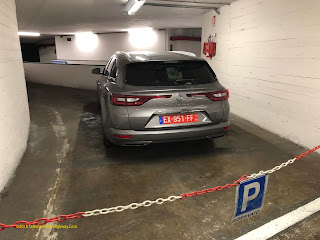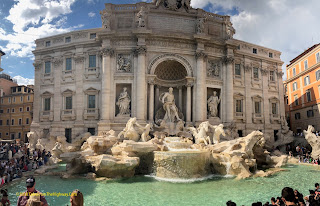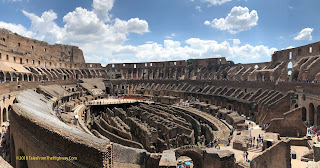After 10 days in Rome we hit the road and moved 150 miles further
south to Trecase - a town about 15 miles south of Napoli.
After the hustle and bustle of the big city, our next stop was a small cottage
located on a winery which sits on the slopes of Mt. Vesuvius.
 |
| Our Vesuvio Wine Cottage |
Behind the cottage about 100 meters was the Winery Cantina where they
would bring in Tourists, do wine tastings, and serve a delicious 3 course dinner with the tasting.
Our view from the cottage was across the vineyards, down to the Mediterranean,
with the Sorrentine Peniinsula (L) and the Isle of Capri (R) in the distance
 |
| Our View |
We even had a pool!
 |
| Pool with Mt Vesuvius behind. |
One afternoon after our travels, we went to the Cantina for a late lunch/early supper.
 |
| Wine Tasting at Cantina Vesuvio |
Pompeii
Of course our main reason for coming south was to (re) visit Pompeii as well
as see Pompeii's lesser known neighboring city Herculaneum.
First was our trip to Pompei.
Below is the large square that made up the forum.
It was surrounded by the municipal buildings and temples and constituted
the center of Political, Religious, & Economic life in the city.
Mosaics flooring (much now gone) covered much of the floor in the
homes of the wealthier residents.
The walls were covered with a thick limestone based plaster.
The dried paints, mixed with water, was then applied to the wet plaster.
It would soak into the drying plaster and become an integral part of the wall
The houses consisted of a similar layout with eating and sleeping spaces being arranged around
the central and open public spaces of the home.
Light for the private spaces almost exclusively came from these interior open areas.
Below - The House of Paquius Proculus was built about 200BC and belonged
to an influential Pompeii citizen.
One of the best preserved mosaic floors in Pompeii it has dogs guarding the entrance,
followed by military decorations, and finally assorted animals and decorative designs
including a swastika.
 |
| House ofi Paquius Proculus |
Below - A mosaic floor in the House of the Faun.
The largest house in Pompeii - it was almost 3,000 sq meters (32,000 sq ft) in size!
The mosaic floor below depicts Alexander the Great leading the battle of Issus in 333 BC
 |
| The Alexander Mosaic |
Below, a cast made of a deceased resident along with bottles found through out the ruins.
The bodies, buried in the ash - would eventually decompose and leave a void in the ash.
It would then be filled with plaster to make a cast.
A street in Pompeii which shows the track the charriots
and wagons left on the stone.
The three large stones in the middle of the road are crossing stones.
Sort of a Roman Crosswalk.
Pedestrians would step from stone to stone to cross the street thereby
staying out of any dirt, mud, water, or other mess that might have been on the roads.
They also made it easier than stepping down into the street and back up the high
curbs onto the sidewalks
Herculaneum
Having been to Pompeii before - it was nice to re-visit, but we were really looking forward to
our visit to Herculaneum (Italian: Ercolano) the lesser known, richer, and better preserved
neighbor to Pompeii.
Herculaneum was spared the wrath of Vesuvius at first.
The most destructive rock and ash fell on Pompeii the first day collapsing roofs and it
was not until later the next night that the column of ash, which had reached
up into the Trophsphere - finally collapsed upon the
flanks of Vesuvius and buried Herculaneum under 50 - 60 feet of ash!
In the pictures below you can see the ruins,
with the current level of the ground towering above.
The arched openings in the foreground were the boat houses at the edge of the sea.
The green plants below was where the sea used to reach.
In the house of the skeleton, so named due to it being the first house where a body was found
in 1831 - it was thought prior to then that all the inhabitants had escaped.
On one wall of the Triclinium (Dining room) is a mosaic Lararium which is a
shrine to the household gods.
 |
| Lararium in House of the Skeleton Herculaneum |
Decorative Frieze's in the House of the Skeleton
Below - an ancient cafe, called a Thermoplia.
The patrons would sit at the counter and eat lunch from
the jars that would be placed in the holes in the counter
 |
| Thermoplia in Herculaneum |
Next... the central bathhouse.
It was divided into a mens and woman's changing room with a central Tepidarium (warm room)
a Frigidariaum (cold bath room) which contained a cold bath plunge
to close the pores after the warm treatments and a
Calderium (Hot Room).
These rooms were heated by hot air that circulated both under the floor and in ducts
inside the walls of the rooms.
Below is the changing room. Cubbys line the wall where clothing could be left and at the far end
a large basin where you would wash up prior to entering the baths.
The general order of bathing was warm room (Tepidarium) to Hot Room(Calderium)
and finish up with the cold Frigidarium, however that was not a rule.
 |
| Changing Room |
Some of the fine decoration above the large wash basin remains to give one
an idea as to how beautiful the baths would have been.
Below is the warm room
 |
| The Tepidarium |
Below - The Calderium was the hot room.
At the far end by the people, is a marble lined tub that would have been filled with hot water.
Behind me was a large sink on a pedastal.
Now mostly gone - the floors were covered in Mosaic tiles as is most of the
yellow white and red wall decorations.
 |
| Calderium in Herculaneum |
Because the ruins Herculaneum was only discovered in the 1700's it has survived most
of the looting, and poor archeological techniques that has plagued its' larger cousin.
The pyroclastic flows that covered the city also preserved organic materials
so much of the original decorations, wood and other organic materials have survived in
amazingly fine condition.
The College of the Augustales (below) is thought to have been the meeting
place of the Augustales - a cult in memory of the the Emperor Augustus.
It contained some particularly interesting, and well preserved frescos.
 |
| Fresco of Hercules seated next to Juno and Minerva |
 |
| Hercules fights Acheolous |
Another amazing residence was The House of the Neptune Mosaic.
The owner of this house owned the wine shop next door (shown below) as
the two building were connected internally.
As the house lacked a back yard, this room was considered a "summer dining room"
In the center was a pond, filled by rain water.
The wall on the left was decorated with hunting scenes with dogs and deer surrouned by
decorative elements, and the rear wall contained a mosaic showing Neptune and Amphitrite,
and is from which the house was named.
On both sides of the mosaic were further decorative floral scenes.
Upstairs in the house was found intact bed, tables and other furniture.
Connected to the house was the owners wine shop.
One of the best preserved shops from antiquity - when found, it appeared as it did
on the day of the eruption in August 79 AD!
The wood shelves, and railings are all original.
The shelves are still stocked with amphora. Some were found to contain chick peas.
In another house I just had to get a close up shot of this detail in the fresco.
As you look at the artwork you can see the shading used by the artist in creating the
3 dimensional appearance.
Every house was decorated with original works of art!
Each home was one of a kind!
Our visit was wrapping up - but before we did - we wanted to go down to the boathouses
where the ancient sea use to lap at the shore.
We took the ancient tunnel down to the old sea bed.
 |
| Tunnel from the city down to the shoreline. |
While it had been thought that all the residents, having had ample warning, had escaped...
300 people had not!
After hiding in the beachside boat houses all day, the refugees from Herculaneum
had probably assumed that the worst was over.
Vesuvius had been erupting since about noon, and other than the rain of some pumice and ash
there seemed to be no real danger.
But as these 300 men, woman, and children hid in the boat houses...
likely debating what to do next...
The massive cloud of hot gas and ash that had risen all day....
10's of thousands of feet into the sky... Suddenly collapsed during the night!
When it did - it sent a cloud of superheated gas roaring into town at speeds of over 100 mph.
The people in the boat houses were killed instantly.
Scientists who have analyzed the skeletons say that there is no sign of warning and
that the bodies were all in relaxed poses.
The photo below seems to show that.
On the right a couple seems to be laying down, "spooning"
Perhaps asleep?
One on the left seems to be curled up in fetal position.. also sleeping?
The bodies were not found until 1980.
A final parting view of Herculaneum.
The boathouses are located below in the foreground.
Much of the city remains un excavated today.
Today the emphasis is on preserving what has been uncovered before any
further digs are attempted.
So as the world waits to see what else may be hidden...
Herculaneum continues to guard its riches deep below the surface.















































